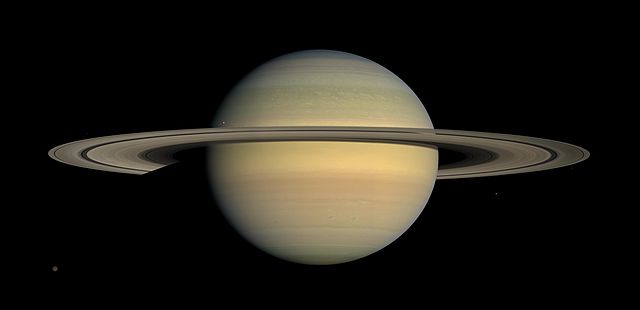
File:Saturn during Equinox.jpg

| |
This is a file from the Wikimedia Commons. Information from its description page there is shown below.
Commons is a freely licensed media file repository. You can help. |
Summary
| Description |
English: This captivating natural colour view of the planet Saturn was created from images collected shortly after Cassini began its extended Equinox Mission in July 2008.
Español: Esta foto de colour natural del planeta Saturno fue creada de las fotos tomadas por Cassini durante su misión extendida del equinoccio en julio de 2008.
Français : Vue en couleurs naturelles de la planète Saturne, créée d'après des images recueillies par la sonde spatiale Cassini peu de temps avant qu'elle commence sa mission « équinoxe » en juillet 2009. Six lunes sont aussi visibles: Titan (5150 kilomètres de diamètre), Janus (179 kilomètres), Mimas (396 km), Pandore (81 km), Épiméthée (113 km) et Encelade (504 km).
Original Caption Released with Image:
|
||||||
| Date | 23 July 2008 | ||||||
| Source | http://www.nasa.gov/images/content/365640main_PIA11141_full.jpg http://photojournal.jpl.nasa.gov/catalog/PIA11141 | ||||||
| Author | NASA/JPL/Space Science Institute | ||||||
| Permission ( Reusing this file) |
|
|
 |
This image has been assessed under the valued image criteria and is considered the most valued image on Commons within the scope: Saturn. You can see its nomination at Commons:Valued image candidates/Saturn during Equinox.jpg.
|
 |
This image was selected as picture of the day on Wikimedia Commons for 6 October 2009. It was captioned as follows: English: A natural colour view of the planet Saturn during equinox.
Other languages:
Bosanski: Prirodni izgled boja planete Saturn tokom ravnodnevnice.
Català: Vista del colour natural del planeta Saturn durant l'equinocci.
Česky: Snímek Saturnu v pravých barvách za rovnodennosti
Dansk: Et billede i naturlig farve af planeten Saturn ved jævndøgn. Dannet af billeder taget af rumsonden Cassini-Huygens.
English: A natural colour view of the planet Saturn during equinox.
Esperanto: Naturkolora vido de planeto Saturno, kreita per bildoj kolektitaj de Misio Cassini-Huygens ĵus antaŭ ol ĝi ekis sian esploron « ekvinokso » en julio 2008.
Español: Vista en colour real de Saturno durante el Equinoccio
Français : Vue en couleurs naturelles de la planète Saturne, créée d'après des images recueillies par la sonde spatiale Cassini peu de temps avant qu'elle ne commence sa mission « équinoxe » en juillet 2008.
Magyar: A Szaturnusz napéjegyenlőségkor, a Cassini-Huygens űrszonda színhű felvételén
Italiano: Immagine in colori naturali di Saturno ottenuta componendo trenta immagini scattate dalla sonda spaziale Cassini nel luglio 2008. Oltre al pianeta sono visibili anche sei delle sue lune: Titano, Giano, Mimas, Pandora, Epimeteo e Encelado.
Македонски: Поглед на планетата Сатурн за време на рамноденица.
Malti: Stampa bil-kuluri naturali tal-pjaneta Saturnu matul l-ekwinozju.
Nederlands: een warekleurenbeeld (door de Cassini-Huygens) van de planeet Saturnus tijdens de equinox (nachtevening)
Polski: Planeta Saturn w naturalnych barwach podczas równonocy.
Português: Planeta Saturno durante equinócio.
Русский: Фотография Сатурна в естественных цветах, сделанная зондом Кассини в июле 2008 года
Українська: Світлина Сатурна в природних кольорах, створена із світлин, зроблених зондом космічної станції Кассіні невдовзі після продовження її місії в липні 2008 року
中文(简体): 处于昼夜平分点的 土星
中文(繁體): 處於晝夜平分點的 土星
|
File usage
I want to learn more...
All five editions of Schools Wikipedia were compiled by SOS Childrens Villages. The world's largest orphan charity, SOS Children's Villages brings a better life to more than 2 million people in 133 countries around the globe. Want to learn more? Go to http://www.soschildrensvillages.org.uk/sponsor-a-child



